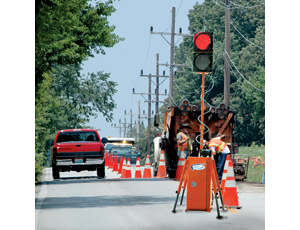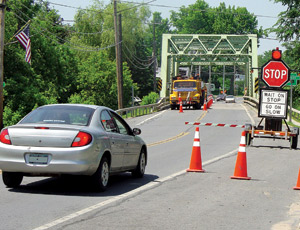For a highway construction worker, focusing on the job is easier when someone is watching your back. On many roads, that person is the flagger, whose stop/slow sign helps maintain a peaceful, safe balance between traffic and work-zone activity.


Unfortunately, not enough motorists watch out for the flaggers; according to the U.S. Bureau of Labor Statistics, 88 flaggers were killed on the job between 2003 and 2009. A concern for safety has given rise to Automated Flagger Assistance Devices (AFADs), remote-controlled traffic control systems that workers can operate away from the road.
AFADs typically employ a combination of regulation 7-ft-high stop/slow paddles, red and yellow lights, movable gate arms and reflective materials. Designed for mobility and quick assembly, most units are trailer-mounted, but others can be relocated by hand.
Although AFADs have been around since the mid-1990s, it took several years of state-level testing before they received full approval from the Federal Highway Administration in the 2009 Manual on Uniform Traffic Control Devices (MUTCD). The paramount concern was whether drivers would obey a machine.
Scott Stotlemeyer, technical support engineer for the Missouri Dept. of Transportation, says, “Everyone recognizes the stop/slow paddles, but would drivers react differently without a person in plain view?” Another issue has been signage. “[The sign] ’flagger ahead’ isn’t entirely accurate,” Stotlemeyer adds.
During trials by the Kansas Dept. of Transportation, Southwest district maintenance engineer Ron Hall found AFADs could do their jobs too well. When a motorist didn’t proceed after the device gave the go-ahead, his first thought was that a technical problem had occurred.
“It turned out the motorist was so fascinated by the AFAD, he wanted to stay and see it go around again,” Hall says.
Collaboration with DOTs has helped AFAD makers fine-tune designs by building on their own crash and wind-resistance tests. Safety Technologies, based in Red Wing, Minn., began developing its AutoFlagger system with the Minnesota Dept. of Transportation in 1994 after the death of a 19-year-old flagger.
“MnDOT’s assistance in testing was very helpful in a multiyear iterative process to develop an effective traffic control device,” says Dave Jones, Safety Technologies’ national sales manager. The agency’s emphasis on ruggedness and visibility is evidenced in the AutoFlagger’s sturdiness and size, he adds. A pair of the trailer-mounted devices costs about $26,900.
Thanks to this extensive testing, AFADs have become a relatively mature technology. Most models, such as the $10,000 to $13,000 RCF 2.4 AFAD from North American Traffic, Port Colborne, Ontario, are powered by solar-rechargeable batteries. They also operate on ultra-high interference-resistant frequencies.
“A lot of improvements over the years have focused on making the devices as simple to operate as possible,” notes Justin DiFrancesco, North American Traffic vice president.
While AFADs have generally earned high marks from DOTs and contractors who have tried them, manufacturers say the devices’ inclusion in the MUTCD didn’t cause a surge of new buyers because the technology is too disruptive. “An AFAD is a giant leap from manual flagging, something that agencies and contractors are familiar with,” observes Steve Stoltz, national sales manager for Intelli-Strobe, Springfield, Mo., which offers the trailer-mounted W1-AGTMS and WS1-AGTMS models at $21,000 per pair.
Concerns also exist about potential malfunctions, even though most AFAD control systems incorporate fail-safes. Moreover, the MUTCD requires a human operator for each unit, though a single worker can manage both ends of a work zone if he or she is in clear view.
In August, the Texas Transportation Institute will complete a two-year study, commissioned by the Texas Dept. of Transportation, on the effectiveness of AFADs. The research combines comprehension surveys of various AFAD systems compared with human flaggers as well as field studies around San Antonio and Bryan-College Station.
“We’re also talking to motorists, so [the study] will have subjective data to accompany the qualitative results,” says Melissa Finley, TTI associate research engineer.
Though AFAD buyers must weigh performance, cost and their own needs, the best return on investment remains flaggers’ lives, experts say. DiFrancesco says that, every year, two or three units from North American Traffic’s rental fleet return from the field bearing the scars of car collisions. “We figure those could have easily been people,” he says.




Post a comment to this article
Report Abusive Comment